The European Central Bank is finally launching its major quantitative easing (QE) in order to fight the euro zone’s slide towards deflation. But with the evident failure of this monetary policy so far and the emergence of negative interest rates, is the ECB creating the perfect storm for virtual currencies as a viable alternative?
From March this year until September 2016 the ECB will buy €60 billion (US$68 billion) of assets a month, a total of €1.1 trillion over the given period. Moreover, the President of the ECB, Mario Draghi, left room to extend the program if necessary. The ECB has been historically slow to take action and that begs the question whether this is “too little, too late.”
What is Quantitative Easing?
Quantitative easing (QE) is monetary policy used by a central bank to stimulate an economy when standard monetary policy has become ineffective. This is done by the a central bank buying assets from commercial banks and other financial institutions in order to increase asset prices and lower yields.
This policy is expansionary because at the same time it increases the monetary base. i.e. the amount of money in the system. The purpose of this is to try and stimulate an ailing economy and can be done in a variety of ways.
The ECB has only one mandate, which is a target based inflation number, as opposed to the Federal Reserve, which has 2 mandates that consist of a target based inflation number and a target based unemployment number.
Currently, a whole slew of countries in Europe (Germany, Finland, Switzerland, Denmark, Netherlands, Sweden and Austria) have negative interest rates. This means borrowers are paying lenders to hold their bonds. This suggests that people perceive these bonds as extremely safe and are willing to pay to hold them due to the risk averse nature of European investors.
QE has been launched to move investors out on the risk spectrum and into riskier asset classes, which in theory will help stimulate the EU and create a wealth effect and trickle down to all citizens. Unfortunately, this is usually not the case.
The EU has failed in their inflation target number, and as mentioned above are fighting off massive deflation. The chart below shows this:
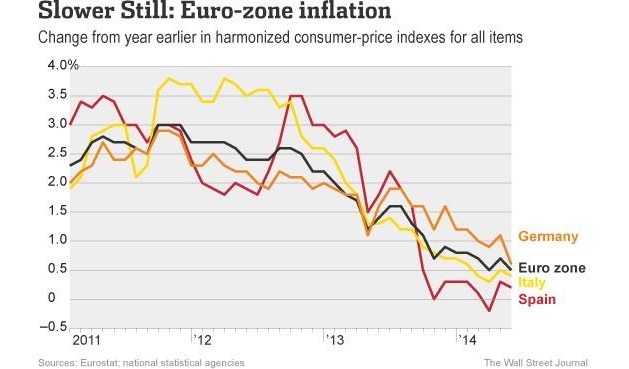
Implications of European QE
As has been mentioned in previous articles, the USD has strengthened against all other major currencies. This is because as the US economy is perceived to be the strongest economy in the world right now, it has stopped asset purchases (QE).
It is also believed by the majority of pundits that the Fed will begin an interest rate hike cycle. Below is a 10 year chart of the USD vs. the Euro. As you can see, the USD has surged to new highs and broken through major resistance levels, while the mirror opposite has happened for the Euro. It has fallen through major support as a result of the announcement of QE and fears of a Grexit.
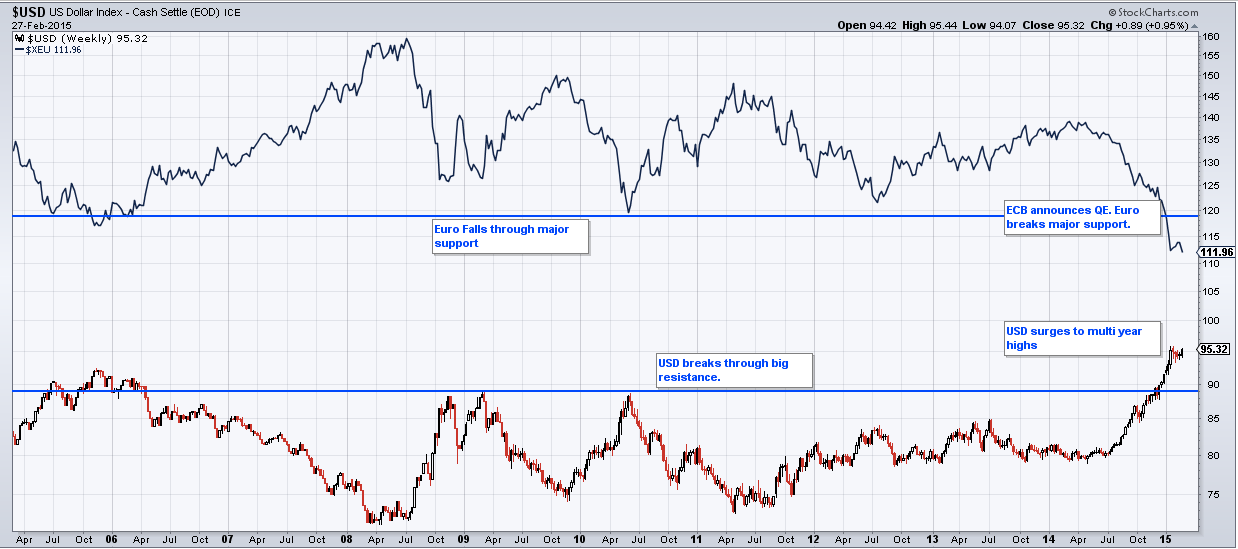
Elliott Wave has put together a great chart of the USD. It appears that this is just the beginning of a larger move that will have really bad implications for commodities and and apply additional deflationary pressure.
Short term the USD might be ripe for a pullback, but the chart below shows that a major new uptrend is underway and has only just started. With 16 Central Banks worldwide actively involved in monetary easing policies, and the Fed looking to tighten at some point relatively soon, this move will very likely continue for the USD.
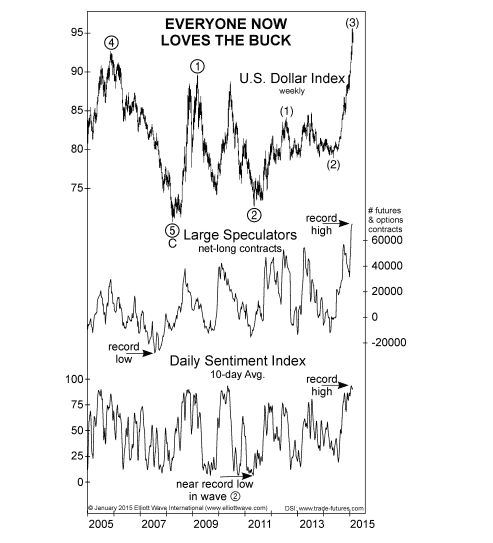
This has also had major implications in the commodities space as the USD and commodities have an inverse relationship. This is mainly due to commodities being priced in USD. Again, this is very deflationary. The chart below shows the USD vs CRB. CRB is an index that includes all major commodities.

This has also had a big impact on bitcoin like all other commodities priced in USD, as it is down dramatically year over year.
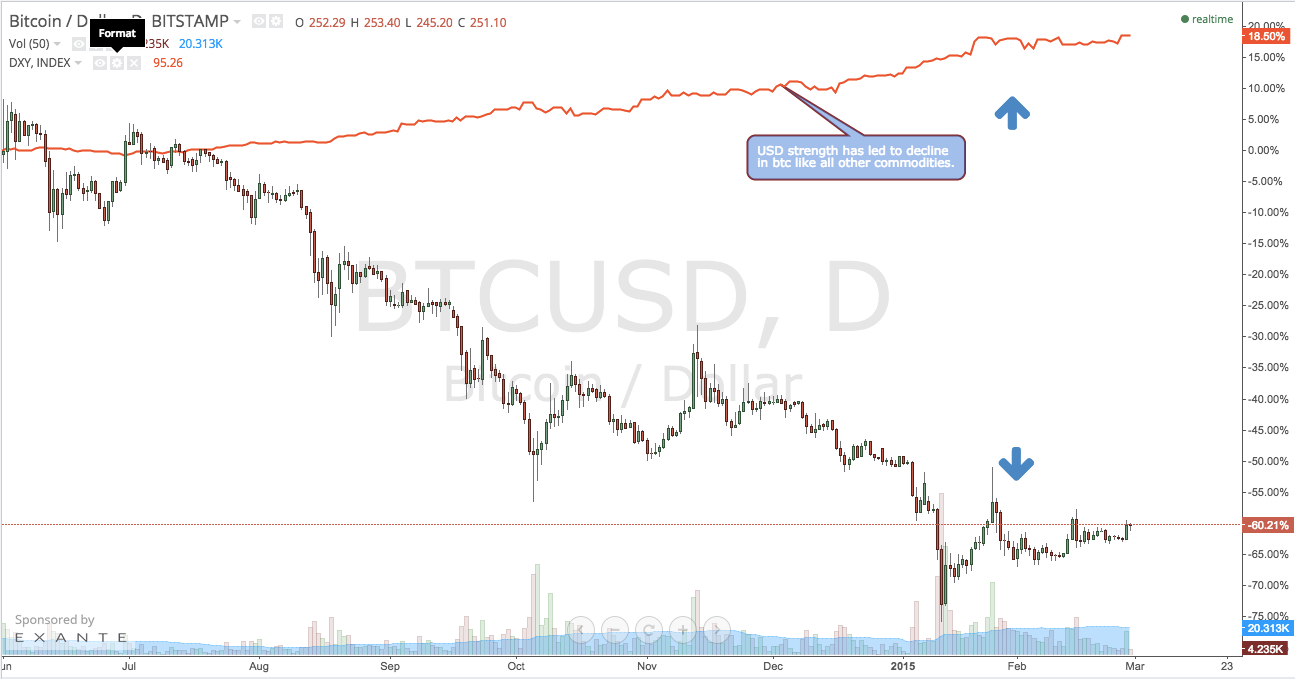
Deflation Is Still Winning
Despite all the monetary policy being used, deflation is still winning. This is a problem because all traditional measures that are being implemented are not working.
While Central Bankers believe they have the answers, it appears they couldn’t be more wrong. Does the chart below represent a successful policy for a recovery? Quite the opposite. What will be even worse are the unintended consequences wrought on the citizens of the world.
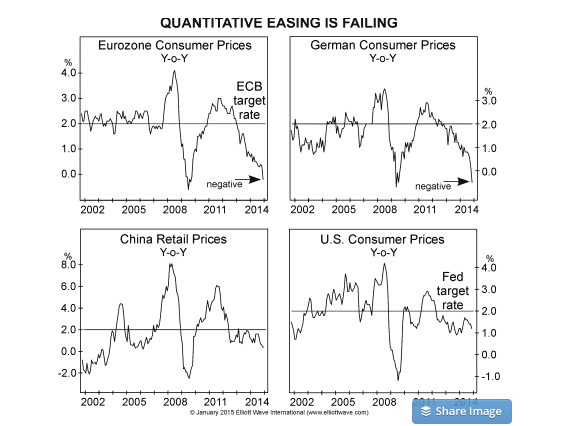
All of these measures are failing despite historic fiscal and monetary easing. Notice that Eurozone prices are already in negative territory, and the trajectory of the others suggests that the rest of world is not far behind. At this point it seems unlikely the ECB will be able to fix a broken monetary union from the throes of deflation and perhaps outright depression that may be on the horizon.
As Central Banks continue to cause currency wars with global fiat devaluation alongside Negative Interest Rate Policies and QE, the existing monetary regime is proving inferior due to irresponsible policies that are simply not working. This opens the door for a new system based on virtual currency, as suggested by Greece’s new Finance Minister, Yanis Varoufakis, to take the torch and build a more transparent ecosystem while providing the necessary liquidity to maintain a healthy economy.
Did you enjoy this article? You may also be interested in reading these ones:
- Greece’s Varoufakis: Bitcoin Can Be Used in Eurozone ‘As Weapon Against Deflation’
- Grexit: Can the EU Survive It Without Hyperinflation?
- New EU Tax Law Could Double Tax Bitcoin and Log Location Data
